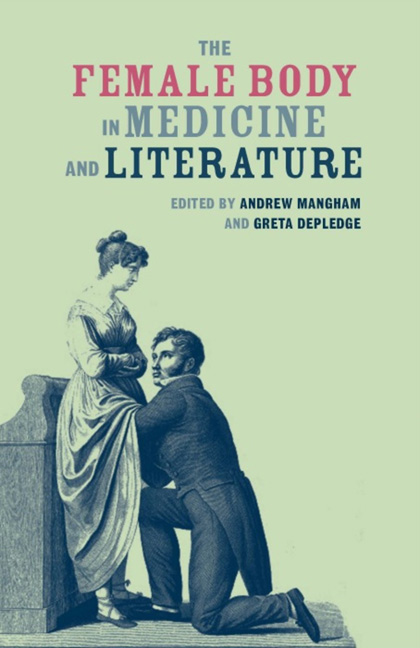Book contents
- Frontmatter
- Contents
- Acknowledgements
- Notes on Contributors
- 1 Introduction
- 2 ‘Difficulties, at present in no Degree clear'd up’: The Controversial Mother, 1600–1800
- 3 Monstrous Issues: The Uterus as Riddle in Early Modern Medical Texts
- 4 Surveilling the Secrets of the Female Body: The Contest for Reproductive Authority in the Popular Press of the Seventeenth Century
- 5 ‘Made in Imitation of Real Women and Children’: Obstetrical Machines in Eighteenth-Century Britain
- 6 Transcending the Sexed Body: Reason, Sympathy, and ‘Thinking Machines’ in the Debates over Male Midwifery
- 7 Emma Martin and the Manhandled Womb in Early Victorian England
- 8 Narrating the Victorian Vagina: Charlotte Brontë and the Masturbating Woman
- 9 ‘Those Parts Peculiar to Her Organization’: Some Observations on the History of Pelvimetry, a Nearly Forgotten Obstetric Sub-speciality
- 10 ‘She read on more eagerly, almost breathlessly’: Mary Elizabeth Braddon's Challenge to Medical Depictions of Female Masturbation in The Doctor's Wife
- 11 Mrs Robinson's ‘Day-book of Iniquity’: Reading Bodies of/and Evidence in the Context of the 1858 Medical Reform Act
- 12 Rebecca's Womb: Irony and Gynaecology in Rebecca
- 13 Representations of Illegal Abortionists in England, 1900–1967
- 14 Afterword: Reading History and/as Vision
- Index
1 - Introduction
- Frontmatter
- Contents
- Acknowledgements
- Notes on Contributors
- 1 Introduction
- 2 ‘Difficulties, at present in no Degree clear'd up’: The Controversial Mother, 1600–1800
- 3 Monstrous Issues: The Uterus as Riddle in Early Modern Medical Texts
- 4 Surveilling the Secrets of the Female Body: The Contest for Reproductive Authority in the Popular Press of the Seventeenth Century
- 5 ‘Made in Imitation of Real Women and Children’: Obstetrical Machines in Eighteenth-Century Britain
- 6 Transcending the Sexed Body: Reason, Sympathy, and ‘Thinking Machines’ in the Debates over Male Midwifery
- 7 Emma Martin and the Manhandled Womb in Early Victorian England
- 8 Narrating the Victorian Vagina: Charlotte Brontë and the Masturbating Woman
- 9 ‘Those Parts Peculiar to Her Organization’: Some Observations on the History of Pelvimetry, a Nearly Forgotten Obstetric Sub-speciality
- 10 ‘She read on more eagerly, almost breathlessly’: Mary Elizabeth Braddon's Challenge to Medical Depictions of Female Masturbation in The Doctor's Wife
- 11 Mrs Robinson's ‘Day-book of Iniquity’: Reading Bodies of/and Evidence in the Context of the 1858 Medical Reform Act
- 12 Rebecca's Womb: Irony and Gynaecology in Rebecca
- 13 Representations of Illegal Abortionists in England, 1900–1967
- 14 Afterword: Reading History and/as Vision
- Index
Summary
This collection draws on two research contexts that are distinct in their disciplinary character yet linked inexorably in the development of British culture: literature and the history of medicine. Like many of the historicist and interdisciplinary studies that have emerged in recent years, this volume aims to draw on the strengths of two forms of knowledge and their attendant methodological practices in order to provide a thoughtful and productive consideration of the ‘treatment’ of the female body between, approximately, 1600 and 2000. The positioning of women vis-à-vis the man of science is a subject that enters a busy and exciting field of study: feminist approaches to literature and historical considerations of medicine have, for quite some time now, retained an unyielding focus on the female body. Yet although there have been some excellent discussions of the links between psychiatric treatments of women and literature, there remains no single work, to date, that fully explores the impact of women's surgery, gynaecology, and obstetrics on literary production. Nor has there been, conversely, a sustained consideration of how literary trends and styles have shaped the course of gynaecology and other branches of women's medicine. Working at the interface of medical history from another direction (that which acknowledges literature as a key player in the formation of our current understandings of the female body), this volume seeks to augment the existing body of work by stressing the ways in which the science draws upon, modifies, and learns from the ‘metaphors, myths, and narrative patterns’ of popular literature.
Historical considerations of the development of women's medicine have tended to use literary models sparsely; and when used at all, they have been briefly and inadequately acknowledged as evidence of how a particular development in medicine became so pervasive that literary figures exploited it as a means of making their novels marketable and topical. We do not suggest that in many cases this is untrue, but we do aim to underscore the need to accept how the complex intersections between medicine and literature have been of great benefit to the former as well as the latter. Gillian Beer famously observed that the inspired relationship between science and literature has involved intellectual traffic that is ‘two-way’.
- Type
- Chapter
- Information
- The Female Body in Medicine and Literature , pp. 1 - 15Publisher: Liverpool University PressPrint publication year: 2012

